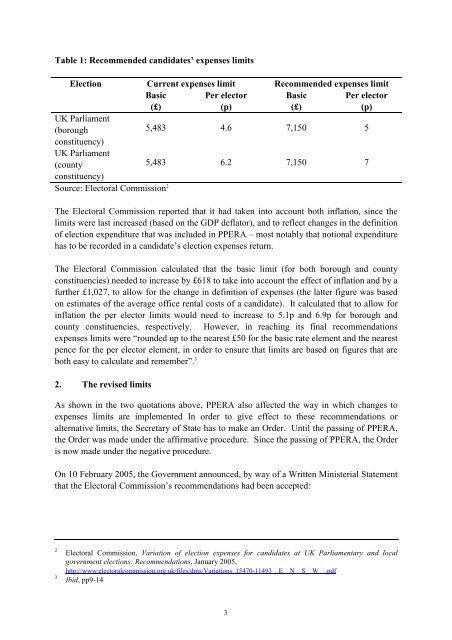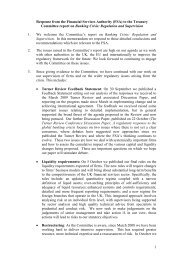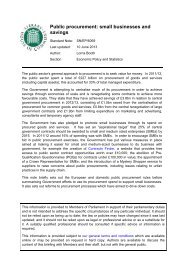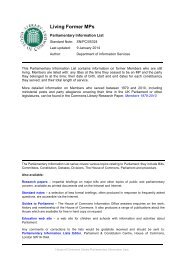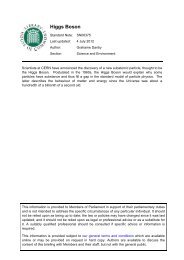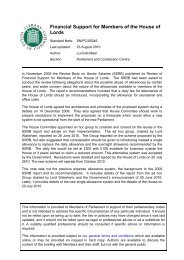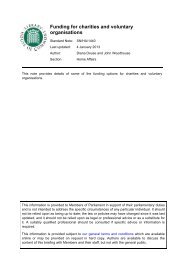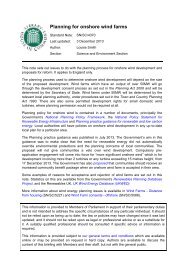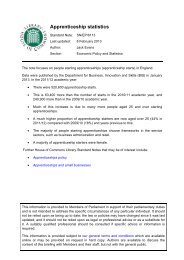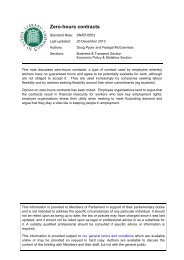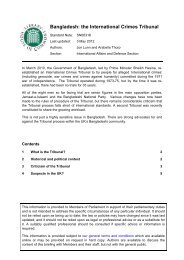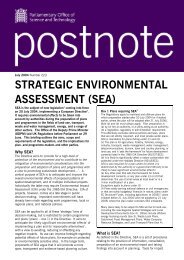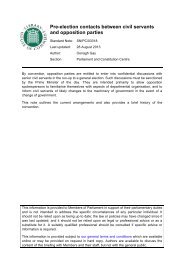Elections expense limits - Parliament
Elections expense limits - Parliament
Elections expense limits - Parliament
You also want an ePaper? Increase the reach of your titles
YUMPU automatically turns print PDFs into web optimized ePapers that Google loves.
Table 1: Recommended candidates’ <strong>expense</strong>s <strong>limits</strong><br />
Election Current <strong>expense</strong>s limit Recommended <strong>expense</strong>s limit<br />
Basic<br />
(£)<br />
Per elector<br />
(p)<br />
Basic<br />
(£)<br />
Per elector<br />
(p)<br />
UK <strong>Parliament</strong><br />
(borough<br />
5,483 4.6 7,150 5<br />
constituency)<br />
UK <strong>Parliament</strong><br />
(county<br />
5,483 6.2 7,150 7<br />
constituency)<br />
Source: Electoral Commission 2<br />
The Electoral Commission reported that it had taken into account both inflation, since the<br />
<strong>limits</strong> were last increased (based on the GDP deflator), and to reflect changes in the definition<br />
of election expenditure that was included in PPERA – most notably that notional expenditure<br />
has to be recorded in a candidate’s election <strong>expense</strong>s return.<br />
The Electoral Commission calculated that the basic limit (for both borough and county<br />
constituencies) needed to increase by £618 to take into account the effect of inflation and by a<br />
further £1,027, to allow for the change in definition of <strong>expense</strong>s (the latter figure was based<br />
on estimates of the average office rental costs of a candidate). It calculated that to allow for<br />
inflation the per elector <strong>limits</strong> would need to increase to 5.1p and 6.9p for borough and<br />
county constituencies, respectively. However, in reaching its final recommendations<br />
<strong>expense</strong>s <strong>limits</strong> were “rounded up to the nearest £50 for the basic rate element and the nearest<br />
pence for the per elector element, in order to ensure that <strong>limits</strong> are based on figures that are<br />
both easy to calculate and remember”. 3<br />
2. The revised <strong>limits</strong><br />
As shown in the two quotations above, PPERA also affected the way in which changes to<br />
<strong>expense</strong>s <strong>limits</strong> are implemented In order to give effect to these recommendations or<br />
alternative <strong>limits</strong>, the Secretary of State has to make an Order. Until the passing of PPERA,<br />
the Order was made under the affirmative procedure. Since the passing of PPERA, the Order<br />
is now made under the negative procedure.<br />
On 10 February 2005, the Government announced, by way of a Written Ministerial Statement<br />
that the Electoral Commission’s recommendations had been accepted:<br />
2<br />
3<br />
Electoral Commission, Variation of election <strong>expense</strong>s for candidates at UK <strong>Parliament</strong>ary and local<br />
government elections: Recommendations, January 2005,<br />
http://www.electoralcommission.org.uk/files/dms/Variations_15470-11493__E__N__S__W__.pdf<br />
Ibid, pp9-14<br />
3


